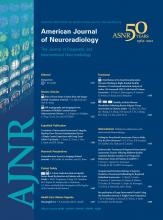Abstract
BACKGROUND AND PURPOSE: Recent studies have shown that selective regional, but not global, GM atrophy occurs from clinical onset to conversion to clinically definite MS. Our aim was to investigate the difference in the extent of SDGM and cortical atrophy in a large sample of patients with CIS and early RRMS and to explore the relationship between SDGM and cortical atrophy and other MR imaging and clinical outcomes.
MATERIALS AND METHODS: Two hundred twelve patients with CIS recruited at the first clinical event (mean age, 29.3 years; median EDSS, 1.5; median disease duration, 3 months) and 177 patients with early RRMS (mean age, 30.7 years; median EDSS, 2.0; median disease duration, 47 months) were imaged on a 1.5T scanner by using a high-resolution 3D T1 spoiled gradient-recalled sequence. Volumetric data for SDGM structures were obtained by using FSL FIRST, while whole-brain, GM, white matter, cortical, and lateral ventricle volumes were estimated by using SIENAX software. Comparisons between the groups were adjusted for age and sex.
RESULTS: Patients with early RRMS showed significantly lower SDGM but not cortical volumes compared with patients with CIS. The most apparent SDGM differences were evident in the caudate and thalamus (P < .0001), total SDGM (P = .0001), and globus pallidus (P = .01). Patients with CIS with a median T2 lesion volume >4.49 mL showed lower total SDGM, caudate, thalamus (P < .001), globus pallidus (P = .007), hippocampus (P = .004), and putamen (P = .01) volumes and higher lateral ventricle volume (P = .001) than those with a median T2 lesion volume <4.49 mL. Decreased thalamic volume showed the most consistent relationship with MR imaging outcomes (P < .0001) in patients with CIS.
CONCLUSIONS: Significant SDGM, but not cortical, atrophy develops during the first 4 years of the RRMS. GM atrophy is relevant for disease progression from the earliest clinical stages.
ABBREVIATIONS:
- ASA
- Avonex-Steroid-Azathioprine
- CIS
- clinically isolated syndrome
- EDSS
- Expanded Disease Status Scale
- FSL
- FMRIB Software Library
- GM
- gray matter
- NBV
- normalized brain volume
- NCV
- normalized cortical volume
- NGMV
- normalized gray matter volume
- NLVV
- normalized lateral ventricle volume
- NWMV
- normalized white matter volume
- RRMS
- relapsing remitting MS
- SDGM
- subcortical deep gray matter
- SET
- Study of Early Interferon β 1a Treatment in High Risk Subjects after CIS
- © 2012 by American Journal of Neuroradiology
Indicates open access to non-subscribers at www.ajnr.org












